
Mughan Mahal was one of the historical-geographical and administrative territories.

Mughan Mahal was one of the historical-geographical and administrative territories.
The Mughan Mahal was present in Sabirabad and Saatly Districts. The district governor was Hasan Khan. [1]
In 1821, one fortress (Qalaqayın) and 44 hamlets (some of which are known as Bildik, Ulucali-Khalphali, Mammishli, Kurkandi, Jangan, First Ranjbars, Murids, Second Ranjbars, Garagli, Minbashi, Molla Vaizli, Damamayagali, Ali Sultanli, Şahadlı, Gushtan, Molday, Mustafabeyli, Hashimkhanli, Potular) hosted 500 families. [2] [3] [4]
The residents of the Mughan Mahal were engaged in agriculture, cattle breeding and cotton.
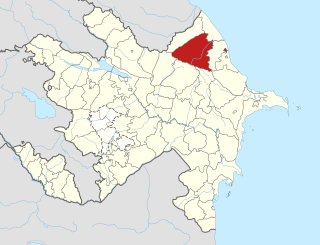
Quba District is one of the 69 districts of Azerbaijan. Located in the northeast of the country, it belongs to the Guba-Khachmaz Economic Region. The district borders the districts of Qusar, Qabala, Ismayilli, Shamakhi, Shabran, and Khachmaz. Its capital and largest city is Quba. As of 2020, the district had a population of 173,400.
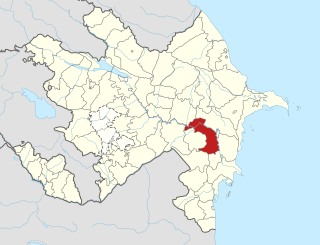
Sabirabad District is one of the 69 districts of Azerbaijan. Located in the centre of the country, it belongs to the Mil-Mughan Economic Region. The district borders the districts of Saatly, Imishli, Kurdamir, Hajigabul, Salyan, Bilasuvar, and the city of Shirvan. Its capital and largest city is Sabirabad. As of 2020, the district had a population of 178,800.

Shirvan Khanate was a Caucasian khanate under Iranian suzerainty, which controlled the Shirvan region from 1761 to 1820.
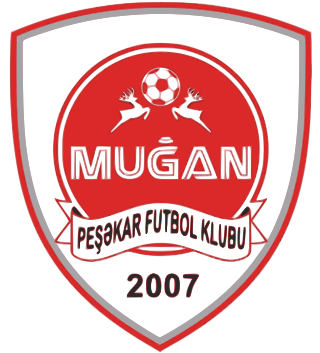
Mughan FK was an Azerbaijani football club, based in Salyan. The club reached the Azerbaijan Premier League for the first time in 2008–2009. The club was first promoted after FK Masallı withdrew for the 2008/09 season. On 31 October 2008, FK NBC Salyan changed its name to FK Mughan.

Quba is a city and the administrative centre of the Quba District of Azerbaijan. The city lies on the north-eastern slopes of Shahdag mountain, at an altitude of 600 metres above sea level, on the right bank of the Kudyal river. It has a population of 47,200 (2023).

Qalaqayın is a village and the most populous municipality, except for the capital Sabirabad, in the Sabirabad Rayon of Azerbaijan. It has a population of 7,658.
The fortress of the historic Javad Khanate and the center of the Mughan district.

Sabirabad is the capital city of the Sabirabad District of Azerbaijan. The city was renamed in honor of the poet Mirza Alakbar Sabir. Sabirabad is the administrative center of Sabirabad District of the Republic of Azerbaijan. In 1935, the district received the status of subordinate city. Sabirabad is located on the right bank of the Kura River. In the vicinity of the city of Sugovushan, the Araz River is merged with the Kur River.

Salyan, is a city and the capital of the Salyan District of Azerbaijan. The city of Salyan is industrialized and known for processing caviar.
The 2009–10 Azerbaijan Premier League was the eighteenth season of top-tier football in Azerbaijan. It began on 14 August 2009 and finished in May 2010. FK Baku were the defending champions.

Jek people are a Northeast Caucasian ethnic group in Azerbaijan. The Jeks are one of the numerically small Shahdag peoples. The Jeks are a part of the Shahdag group of Dagestani people, and inhabit the northeast of the Azerbaijan Republic and Shahdag plateau of the Great Caucasus. The historical motherland of the Jeks is the Jek village of Quba Rayon, and their native language is Jek language, of the Northeast Caucasian family.

The Khinalugs are an indigenous people of Azerbaijan and speak the Khinalug language, a Northeast Caucasian language. The Khinalugs are indigenous to the Quba District and have been named after their main village, Khinalug. It is one of the peoples that have traditionally been called Shahdagh.

The Shirvan province was a province founded by the Safavid Empire on the territory of modern Azerbaijan and Russia (Dagestan) between 1501 and 1736 with its capital in the town of Shamakhi.

The Derbent Khanate was a Caucasian khanate that was established in Afsharid Iran. It corresponded to southern Dagestan and its center was at Derbent.
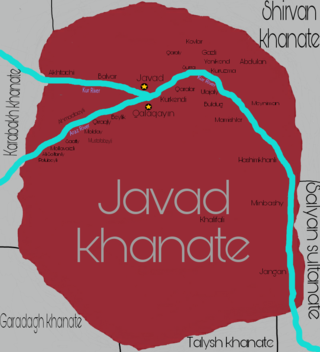
Javad Khanate was a Caucasian khanate with its capital in the town of Javad. It extended from Javad on the Kura River southwest along the east side of the Aras River. It was bordered by the Shamakhy (north), Karabakh (west), Karadagh (southwest) and Talysh khanates (south), and the Salyan Sultanate (east), its territory lays within modern Azerbaijan.
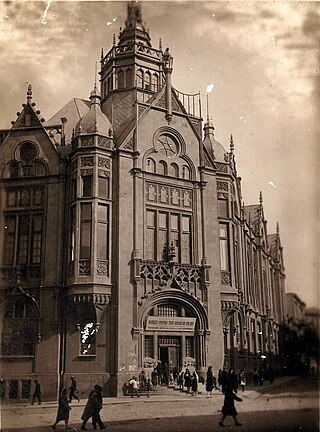
The Ali Bayramov Club was the first club for women in Baku, Azerbaijan. The Club offered a variety of vocational skills and training to women, in additional to cultural and leisure activities. Its main focus was campaigning for women's unveiling and literacy.

Hasan Khan Shahseven was the ruler of Javad Khanate under the suzerainty of the Quba Khanate.

Aydin Balamirza oghlu Mammadov is an Azerbaijani historian, scientist-demographer, specialist on historical demography, Ph.D. in history, and associate professor of the department of "source study, historiography and methods" of Baku State University. He is one of the 100 Notable alumni of Baku State University.
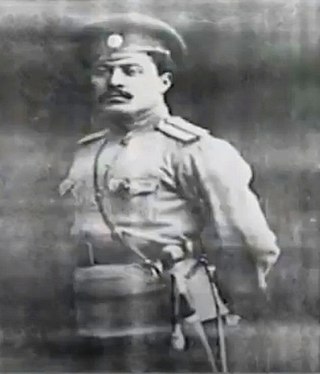
Tarlan Abdullah oglu Aliyarbayov, also known as Tarlan bey Abdullah bey oglu Aliyarbeyov, nicknamed the Tarlan of Shamakhi, was a Soviet military officer who served as a major general in the Red Army, a military educator and a politician of Azerbaijani origin. He previously served in the Imperial Russian and Azerbaijani armies, and served in World War I, for which he was awarded the Order of Saint Stanislaus and the Order of Saint Anna, as well as the Russian Civil War and the Armenian–Azerbaijani War. Aliyarbayov was one of three Azerbaijanis who fought in both World Wars and the Russian Civil War; the others were Ali-Agha Shikhlinski and Samad bey Mehmandarov.
Jeyran Bayramova was an Azerbaijani women's rights activist and politician (Communist). She was a pioneer of the first organized women's movement of her country and the founder of the Ali Bayramov Club, the first organization of the Azerbaijani women's movement.
Hoseyn Ali Khan was the khan (governor) of the Erivan Khanate from 1759 to 1783 and brother of the previous Hasan Ali Khan.
{{cite book}}: CS1 maint: unfit URL (link)